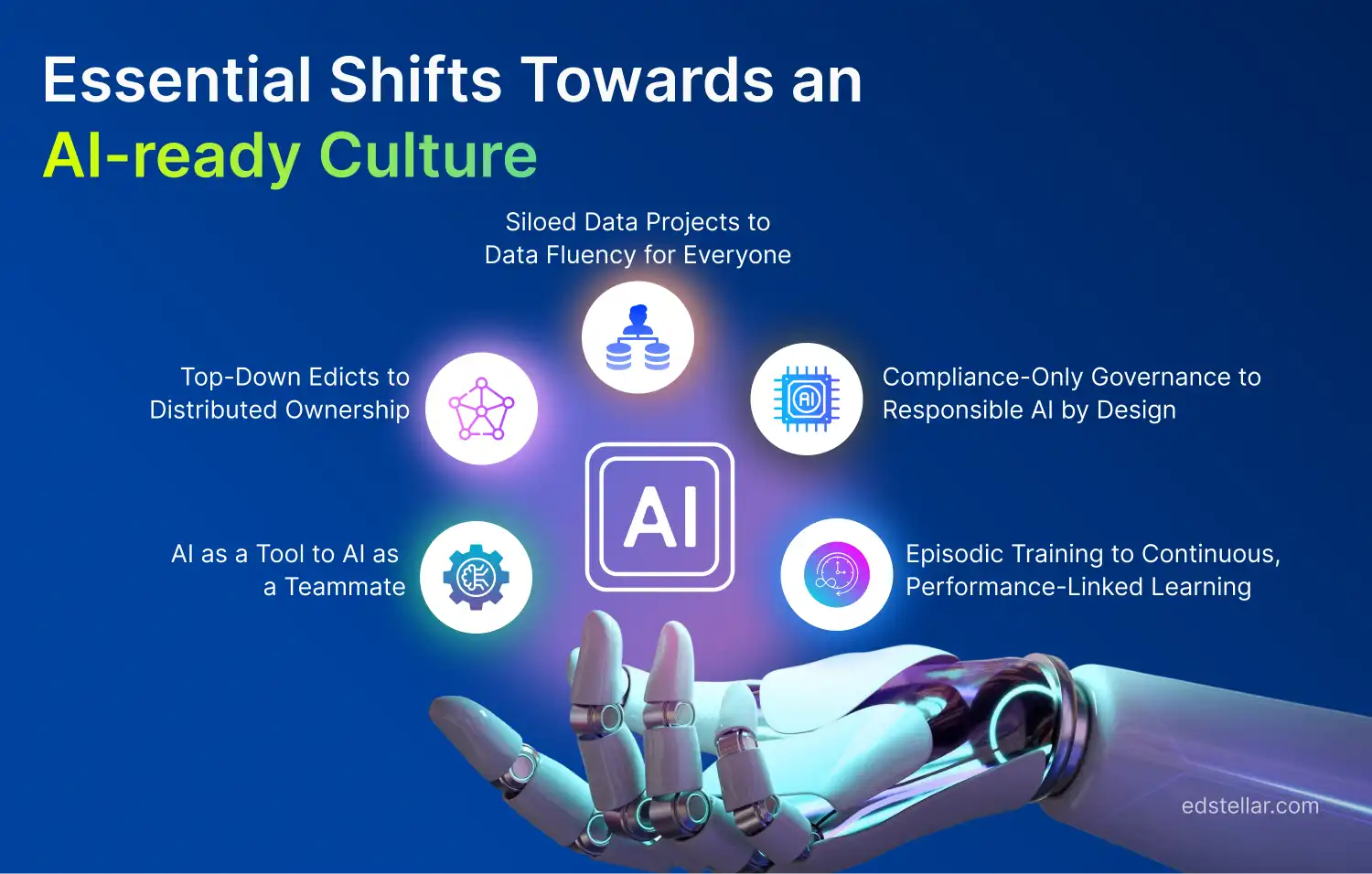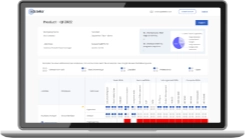
AI is no longer an experiment; it’s everywhere. Today, more than 78% of organizations use AI in at least one part of their business. But here’s the catch: only 1% of enterprises say their AI strategies are fully mature.
Even among companies using generative AI, over 80% admit they haven’t yet seen meaningful gains in revenue or efficiency. That’s because adopting AI isn’t just a technology challenge, it’s a cultural one.
AI can automate tasks, analyze data, and generate insights, but without a culture that encourages curiosity, learning, and trust in these tools, its potential stays untapped. The companies making real progress aren’t just deploying AI; they’re reshaping how teams think, collaborate, and make decisions.
If you’re leading a team or running a business, your biggest advantage right now isn’t owning the most advanced AI; it’s building a culture that knows how to use it. Technology evolves fast, but culture determines whether it actually drives progress.
These five essential shifts for 2026 will help you turn AI from a side experiment into a competitive differentiator.
The 5 Essential Shifts Toward an AI-Ready Culture
Adopting AI tools is easy; transforming your organization to thrive with them is the real challenge. Building an AI-ready culture requires more than new software; it calls for new ways of thinking, learning, and collaborating.
The following five shifts will help leaders move beyond experimentation and build a sustainable framework where technology and people grow stronger together.

1. From “AI as a Tool” to “AI as a Teammate”
Stop seeing AI as just another software tool. Start treating it as a capable collaborator.
AI isn’t here to replace your people, it’s here to amplify them. Generative AI tools can brainstorm ideas, analyze data, draft reports, and even generate code. But the magic happens when humans and machines work together, combining AI’s efficiency with human empathy, creativity, and critical thinking.
Start small and make the first AI wins clearly human-centered automation should free people to do higher-value work, not leave them chasing errors.
Treat AI like a reliable teammate that removes repetitive work while leaving judgment, exceptions, and final accountability to people. When workflows are re-designed around human + AI collaboration, quality and speed improve together.
How to make it happen:
- Map your workflows and identify where AI can support, not replace, human decision-making.
- Create clear “human-in-the-loop” checkpoints to validate AI outputs.
- Encourage employees to share how they use AI daily, turning insights into best practices.
AI tools that support being a teammate in the workforce:
- Slack: Integrates AI agents for seamless collaboration, real-time updates, and automation in team communication.
- Document360: Centralized knowledge management, AI-powered search, and writing assistant for organizing team workflows efficiently.
- Bit.ai: AI-powered document creation and team collaboration, with robust tracking and wiki options.
- TeamAI: Multiple AI models for teams, enabling collaborative, multi-agent work environments.
2. From Top-Down Edicts to Distributed Ownership
Central platforms and guardrails matter, but domain teams must own outcomes.
Empower everyone to experiment with AI safely and responsibly.
AI transformation shouldn’t be a top-down initiative guarded by IT or data teams. Instead, organizations must encourage distributed ownership, where every department understands and applies AI in its unique context. This democratization fuels innovation from the ground up.
How to Implement Distributed Ownership?
- Create “AI champions” within each department who test and share successful use cases.
- Provide low-code and no-code AI tools so non-technical teams can innovate independently.
- Launch internal AI knowledge-sharing hubs where teams upload prompts, automation scripts, or workflow hacks.
AI tools that facilitate being a distributed owner in the workforce:
- Personal AI: Small Language Model platform for distributed, private, and programmable experiences, ideal for decentralized knowledge practices.
- Collaboration.AI: Facilitates collaborative communities with distributed problem-solving and ownership models.
3. From Siloed Data Projects to Data Fluency for Everyone
AI quality depends on good data, but equally on people who can read model outputs and spot errors. Data fluency is no longer optional for business roles that interact with AI.
So, make data literacy and prompt engineering everyday skills, not specialist privileges.
Remember, AI thrives on high-quality data and clear communication. But if only your data scientists understand how data works, you’re limiting potential. Every employee should be comfortable reading AI outputs, recognizing biases, and crafting effective prompts.
How to Develop Data Fluency for Everyone?
- Introduce mandatory micro-learning modules on data literacy and prompt writing.
- Run “AI fluency days” short, hands-on workshops where teams learn by doing.
- Encourage cross-functional collaboration between data teams and non-technical staff.
AI tools that promote data fluency for everyone in the workforce:
- Quadratic: AI-powered spreadsheets enabling natural language data queries, analysis, and progressive data skill-building for users at all levels.
- Infocepts: AI-powered data fluency assessment and enablement for organizations.
4. From Compliance-Only Governance to Responsible AI by Design
Don’t just follow AI regulations, lead with trust and transparency.
As regulations evolve and public scrutiny grows, companies can’t afford to treat AI ethics as a box-ticking exercise. Trust must be embedded in every system and process from day one.
Regulatory checklists are necessary, not sufficient. Responsible AI means integrating transparency, model cards, evaluation frameworks, and incident playbooks into the lifecycle so users and customers can trust the outputs.
How to Achieve Responsible AI by Design?
- Develop AI model cards that document purpose, limitations, and data sources for every AI system.
- Conduct regular audits for bias, data leakage, and unintended outcomes.
- Be transparent with both employees and customers about where and how AI is being used.
AI tools that encourage responsible AI design within the workforce:
- Google Responsible Generative AI Toolkit: Provides tools and guidance for designing and evaluating responsible AI applications, including model safety, transparency, and compliance features.
- Infosys Responsible AI Toolkit: Open-source toolkit to ensure ethical, secure, and compliant implementations of AI solutions.
- Microsoft Responsible AI Tools: Solutions for risk-mapping, safety compliance, and reducing harm in AI innovation cycles
5. From Episodic Training to Continuous, Performance-Linked Learning
Upskilling for AI can’t be a one-time event; it must become a career-long journey.
Technology evolves faster than annual training schedules. Employees need continuous learning that’s directly tied to performance goals, role evolution, and company strategy.
Upskilling must be practical, business-integrated, and continuous. The companies that scale AI invest in eval tools, on-the-job projects, and feedback loops that tie learning to outcomes.
How to Make Continuous, Performance-Linked Learning Happen?
- Define AI competency levels (basic, intermediate, advanced) and tie them to promotions or performance reviews.
- Offer micro-learning courses that can be completed in under an hour, and applied immediately.
- Establish mentorship programs pairing data-savvy employees with domain experts.
AI tools that promote ongoing, performance-based learning in the workforce:.
- Stellar AI: Delivers AI-powered, targeted training recommendations for every job role, using data-driven insights to identify skill gaps and enhance workforce performance.
- Lingio: Top AI tools for instant, adaptive course creation with continuous assessment and improvement.
Conclusion
Technology can be copied. Culture cannot.
Building an AI-ready culture is about transforming how your organization thinks, learns, and collaborates around intelligent tools.
By focusing on empowerment, data-driven action, collaboration, experimentation, and visionary leadership, you don’t just implement AI, you future-proof your business for 2026 and beyond.
As AI becomes an everyday partner in decision-making, the companies that will win aren’t those with the most advanced algorithms, but those with the most adaptable people.
Whether you want to boost AI literacy, establish a governance framework, or build continuous learning paths, Edstellar can help you embed those five essential shifts into your organization.
FAQs: Building an AI-Ready Culture in 2025
Explore High-impact instructor-led training for your teams.
#On-site #Virtual #GroupTraining #Customized

Bridge the Gap Between Learning & Performance
Turn Your Training Programs Into Revenue Drivers.
Schedule a ConsultationEdstellar Training Catalog
Explore 2000+ industry ready instructor-led training programs.

Coaching that Unlocks Potential
Create dynamic leaders and cohesive teams. Learn more now!


Want to evaluate your team’s skill gaps?
Do a quick Skill gap analysis with Edstellar’s Free Skill Matrix tool

Transform Your L&D Strategy Today
Unlock premium resources, tools, and frameworks designed for HR and learning professionals. Our L&D Hub gives you everything needed to elevate your organization's training approach.
Access L&D Hub Resources.svg)
.svg)



.svg)


.svg)
.svg)
.svg)
.svg)

